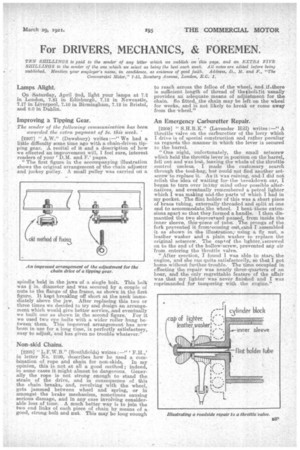For DRIVERS, MECHANICS, & FOREMEN.
Page 37

If you've noticed an error in this article please click here to report it so we can fix it.
TEN SIIIL.LINCS is paid to the sender of any letter which we publish on this page, and an EXTRA SHILLINGS to the sender of the one which we select as being the best each week. All notes are edited before being mablished. Mention your employer's name, in eonadence, as evidence of good faith. Address, D„ N. and P., "The Commercial Motor," 7-15, Be sebery Avenue, London, E.C. 1,
Lamps Alight.
On Saturday, April 2nd, light your lamps at 7.2 in Louden, 7.21 in Edinburgh, 7.12 in Newcastle, 7.17 in Liverpool, 7.10 in Birmingham, 7.12 in Bristol, and 8.0 in Dublin.
Improving a Tipping Gear.
The sender of the following communication has been awarded the extra payment of 5s. this week.
M07-1 " A.W." (Dewsbury) writes We had a
little difficulty some time ago with a chain-driven tipping gear. A recital of it and a description of how we effeeted an improvement will, I feel sure, interest readers of your D.M. and F,' pages.
"The first figure in the accompanying illustration shows the original arrangement of the chain adjuster and jockey pulley. A small pulley was carried on a
spindle held in the jaws of a single bolt. This bolt was ri. meter and was secured by a couple of nuts to the flange of the frame, as shown in the first figure. It kept breaking off short at the neck immediately above the jaw. After replacing this two or three times we decided to try and design an arrangement which would give better service, and eventually we built, one as shown in the second figure. For it we used two 'eye bolts with a wider roller hung between them. This improved arrangement has now , been in use for a long time, is perfectly satisfactory, easy to adjudt,• and has given no trouble whatever."
Non-skid Chains.
[2206] " L.F.W. ." (S outhfields) writes : —" F. H.,' in letter No. 2199, describes how he used a 6om' ibination of rope and chain for non-skids. In my opinion, this is. not at all a good method; indeed, in some cases it might almost be dangerous. Generally the rope in not strong enough to stand the strain of the drive, and in consequence of this the chain breaks, and, revolving with the wheel, gets jammed between wheel and spring, or in amongst the brake mechanism, sometimes causing serious damage, and in any ease involving considerable loss of time A much better way is to join the two end links of each piece of chain by means of a good, strong bolt and nut. This may be long enough to reach across the felloe of the wheel, and.if,there is sufficient length of thread of the! bolt/it usually provides an adequate means of adjustment for the chain. So fitted,,the chain may be left en the wheel for weeks, and is not likely to break or come away from the wheel."
An Emergency Carburetter Repair.
[2209] " (Lavender Hill) writes :—" A throttle valve on the carburetter of the lorry which I drive is of special construction and rather peculiar as regards the manner in which the lever is secured to the barrel. •
"One night, enfoitunately, the small setscrew which held'the throttle lever in position on the barrel, fell outand was lost, leaving the whole of the throttle .control useless. I made the customary search through the tool-bag, but could not find another setserew•to replace it. As it was raining, and-I did not relish the idea of waiting forthe breakdown car, I began to turn over inimy mind other possible alternatives, and eventually remembered a petrol lighter which-I was making and the parts 'of which I had in my pocket. The flint holder of this was a short piece of brass tubing, externally threaded and split at one end to accommodate:the wheel. I bent-these extensions apart BO that they formed a handle. I then di.mantled the two sleevest and passed, from inside the inner sleeve-, t•hiEepiece of tube. The prongs of the fork prevented it frorrecoming out,iand I assembled it as shown in the illustration,using a fly nut, a leather washer and a plain washer to replace the original setscrew. The eaptof the lighter;4serewed on to the end of the hollowiserew, -prevented any air 'from entering the throttle valve.
," After erection, I found 1 was able to stain, the engine, and she ran quite satisfactorily,so that I gob home without further-trouble. The' time occupied in effecting the repair was nearly three-quarters of an home and the only regrettable feature of the affair was that my lighter was 'never finished and I was reprimanded for tampering with the engine."






































